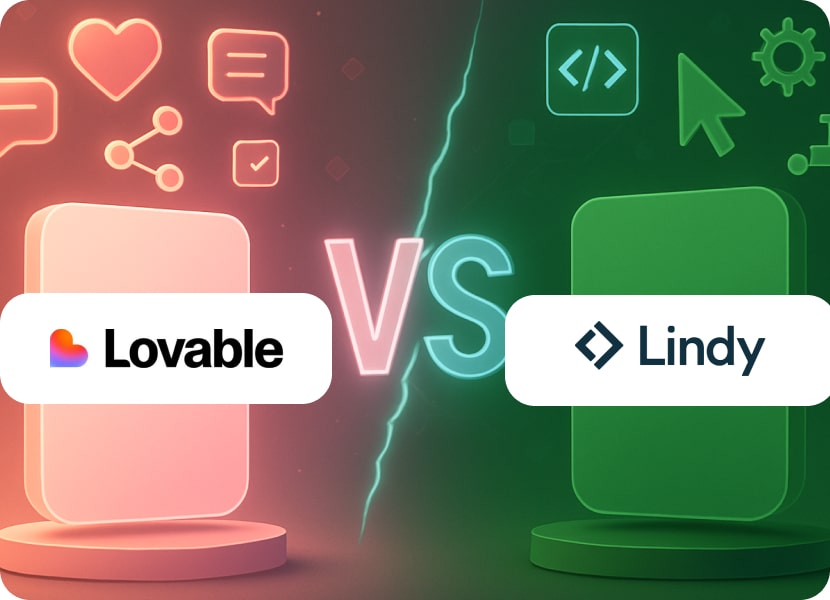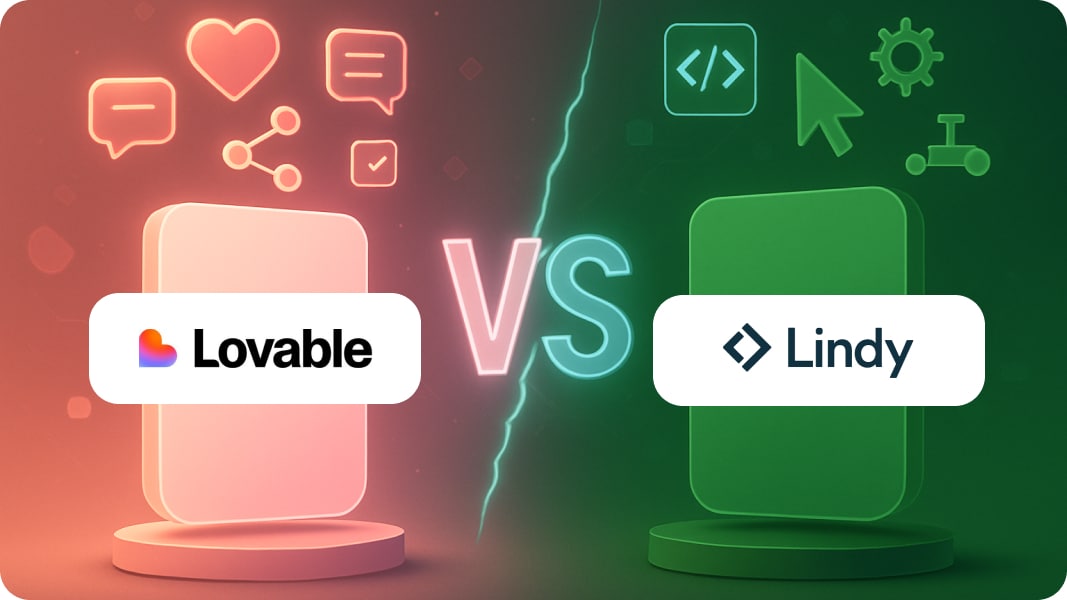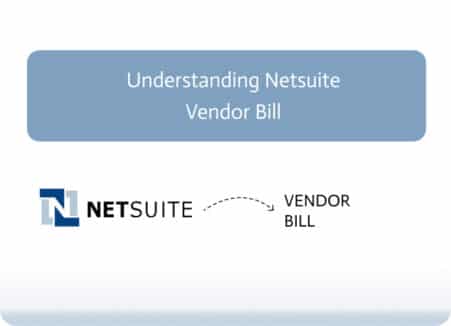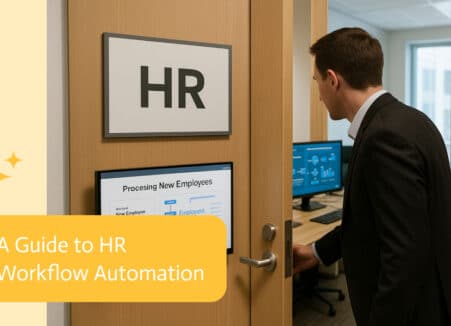

Lovable vs. Lindy AI: Vibe Coding Apps vs. Agents
No one saw this coming, but the biggest fight in vibe coding isn’t about who can build apps faster, but more about whether you should even be building apps at all. The fight between Lovable vs Lindy AI makes this tension very clear. One platform says, “Tell us about your app, watch it come to life, and own the code.” The other says, “Forget about apps; make artificially intelligent agents who do all, or most, of your work for you.”
Lovable just became an AI unicorn with a $200 million raise at a $1.8 billion valuation by letting everyone build apps. Lindy AI went from nothing to serving businesses in every Fortune 500 industry by letting people make “AI employees” that automate tasks without any code being written.
This Lovable vs. Lindy AI comparison is about whether you need software that you own or AI workers that you manage. Let’s get into this captivating competition.
Lovable: The App Factory
Lovable’s growth right now is almost too good to be true. According to their investors, the company reached $100 million within eight months of launching, and retention rates are still high. They’re not just getting bigger, like Noca AI, they’re also showing that conversational app development works on a large scale.
The platform just set Agent Mode as the default experience, and the results are amazing. Agent Mode interprets requests, understands your codebase, fixes problems, makes complicated edits, and cuts down on mistakes by 91%. This isn’t the same Lovable it was six months ago; it’s grown into something much more powerful.
What Makes Lovable Blow Up in 2025
The launch of Lovable Cloud and Lovable AI changed what the platform could do dramatically. Lovable Cloud makes apps, with profiles as well as community platforms with posts, comments, and moderation features, all through conversations. No dashboards or configuration screens from the outside world; just tell us what you want.
Google’s Gemini models power Lovable AI, which lets you add artificial intelligence features to apps just by asking for them. Want to make avatars? Chatbots answering inquiries from customers? You tell Lovable what you want, and they build it. You don’t need keys, separate billing relationships, or to deal with how to respond.
Lovable supports Vue, Angular, Svelte, and Flutter as well as React and Next.js. The “Advanced Settings” feature lets you customize the tech stack to meet certain requirements. You don’t have to stick to one framework anymore.
Real-time analytics just came out, so you can now see how many people are visiting your site, how many pages they view, and how engaged they are right inside Lovable. You can see trends, fix problems, or celebrate your first users without leaving Lovable because data updates almost instantly.
Where Lovable Becomes Difficult
Lovable added end-to-end encryption, security scanning, and user-controlled data policies with 2FA as a standard after a report in April 2025 about “VibeScamming” vulnerabilities. This showed the dangers of quickly developing AI to everyone and exactly why they needed to do a complete overhaul of their security.
The platform is great for apps that follow standard patterns and CRUD apps. When you need a lot of custom architecture, you’ll fight against the rules instead of going along with them.
Lindy AI: The Agent Platform That Wants to Work with You
Lindy AI approaches vibe coding with something slightly different in mind. They asked, “What if you didn’t need to build apps at all?” What if you could just tell AI agents what to do and they would do it on their own?
You’re able to create “AI employees” on the platform without having to code. Lindy AI is about automation for AI agents that doesn’t require any coding. It can handle complicated business processes like qualifying leads via CRM and sorting support tickets and sending them to Slack. You’re not really making any software, you’re more like hiring people to work online, if that makes sense?
What Lindy Has Going for It Right Now
By October 2025, Lindy will be using Claude Sonnet 4.5 as its default mode, which got a 77.2% SWE-bench score. It also has Claude Sonnet 3.7, GPT-5, GPT-5 Codex, Gemini Flash 2.0, and Claude Haiku 3.5. Choosing the right model can help you find a balance between cost and capability, which affects both performance and credit use.
The Claude Sonnet 4.5 integration lets agents work on technically challenging tasks for more than 30 hours without help, with much better coding accuracy. This matters because your agents genuinely deal with sophisticated workflows, so there’s no need for supervising them all the time.
Lindy just released Agent Swarms, which lets one AI agent make copies of itself to do more things simultaneously, like sending hundreds of emails, or even when you need to be carrying out several calls at the same time. That’s how the new age agents can work faster and on a larger scale than people can.
As of now, Lindy works with more than 6,000 apps, including Workspace, Salesforce, Slack, HubSpot, Shopify, and Stripe. Lindy’s Computer Use feature lets agents automate their browsers and move around sites, fill out forms, and get data from any web app. This is useful for platforms that don’t have APIs.
Lindy is certified to meet SOC 2 Type II standards, allowing its use in many industries needing AES-256 encryption. Business Associate Agreements for healthcare, enterprise SSO, role-based access controls, and full logs are just a few security features you’ll have access to.
There are a lot of real-world uses for it, such as managing calendars, sorting through emails, writing meeting notes, reaching out to salespeople, updating CRM systems, managing social media, processing documents, scraping the web, and making phone calls. Lindy agents can even help with sales training by implementing MEDDPICC to find deal factors.
Where Lindy Hits Friction
Lindy charges based on credits, and each agent’s action takes money out of a monthly credit balance. Sending a message only costs a few credits (7 for an email), but longer jobs or multi-step workflows cost more (265 for a short phone call). For complicated automations, credits can run out faster than you think.
One important limitation is that agents are not fully equipped to deal with those really weird scenarios in a predictable way, meaning decision trees that are not straightforward will need to be set up carefully, AI responses differ wildly sometimes, and tasks that need human judgment should have escalation channels. Lindy is best for technical work that requires a thorough comprehension of the context, instead of only mechanical tasks.
Some users say that Lindy is great for companies that need smart automation without a lot of technical complexity. However, enterprise controls like role management, records, and version tracking are still being built. Governance features may not be very useful, especially for those bigger teams that have to handle sensitive workflows.
The Lovable vs. Lindy AI Choice
Choose Lovable when:
- You need real apps, websites, dashboards, and platforms.
- Code ownership is important because you might give it to developers later. Your vibe coding vision is about making products, not giving out tasks.
- You want to be able to add AI features to the apps you control and use.
- Non-technical founders must make the software that runs their business.
- It’s important to be able to export to GitHub and keep working on it somewhere else.
When to choose Lindy AI:
- You want to automate processes that are already in place, not create new software.
- Your vibe coding says, “Get me AI workers who can do things.”
- Connecting with more than 6,000 existing business apps is very important.
- You need agents that can work on their own with email, CRM, Slack, and other tools.
- You must have compliance certifications like SOC 2, HIPAA, and GDPR.
- You want to get rid of repetitive work, not make new apps.
Lovable vs. Lindy AI: The Truth No One Talks About
What makes this comparison so interesting is that both platforms are right about vibe coding, but for very different reasons.
Lovable is right that a lot of companies need custom apps made quickly. A new business needs a customer portal. A store needs a dashboard for its inventory. A community needs a place to talk and keep things in order. Lovable makes software to fix these problems by talking to people.
Lindy AI is right that most businesses are overwhelmed by the same tasks over and over again, which AI agents can do better than people or traditional automation. Lead qualification, scheduling meetings, sorting through emails, and updating the CRM are all workflow problems that agents can solve better than apps ever could.
The platforms aren’t in competition. In the vibe coding revolution, they are solving very different problems.
How Noca Fits into the Vibe Coding Ecosystem
Noca is an AI-first platform made just for making and running AI agents and business workflows. It links together CRMs, ERPs, and older systems, which is a common problem with enterprise automation projects. It also lets teams say what they want in plain language and then deploy agentic workflows that keep running and learning.
In real life, Noca’s strengths are orchestration, enterprise connectors, and agent monitoring. These are the parts of vibe coding that matter when a program needs to update Salesforce, start an ERP process, and show errors to a human reviewer. That doesn’t mean it hasn’t gotten into making really smart autonomous chatbots that act like a vibe-coding tool, though. Noca is a complete tool that can help you make anything from a simple app to something much more complicated.
Vibe coding really pays off for businesses when it comes to tools that can automate across a company’s entire tech stack, not just make front-end prototypes.
The Bottom Line on Lindy AI vs. Lovable
The comparison between Lovable and Lindy AI shows that they are two great platforms that have very different ideas about what vibe coding should do.
Lovable got $200 million at a $1.8 billion valuation to become your full-stack AI engineer. The company made $100 million in recurring revenue in eight months, which shows that building conversational apps works on a large scale. More than half of the Fortune 500 companies use Lovable, which suggests that it is more than just a fad.
Lindy AI became the place where “AI employees” could be made to run business processes on their own. With Claude Sonnet 4.5 integration, Lindy can run on its own for more than 30 hours and connect to more than 6,000 apps. This means that in the future, you will be able to manage AI agents instead of writing code.
In the vibe coding ecosystem, neither platform is always better than the other. They work best for very different kinds of problems. It all comes down to whether you need software or workers when you choose Lovable or Lindy AI.
Want to make and own your own apps? Adorable. Want AI agents to take care of your current workflows? AI Lindy.
Want to make things that your business needs? Lovable’s full-stack method is the best. Want to get rid of repetitive tasks in tools you already have? Lindy’s agent model works.
Making MVPs to quickly test ideas? Lovable gives you apps that you can use right away. Automating CRM updates and sales outreach? Lindy gives you agents that work on their own.
The vibe coding revolution isn’t about one way of thinking winning. It’s about having the right tool for the job, whether that job is writing new software or letting AI do some of the work you already have. Lovable and Lindy are both pushing the revolution forward, but they are doing so from opposite sides and heading to two very different but equally important and necessary places.

